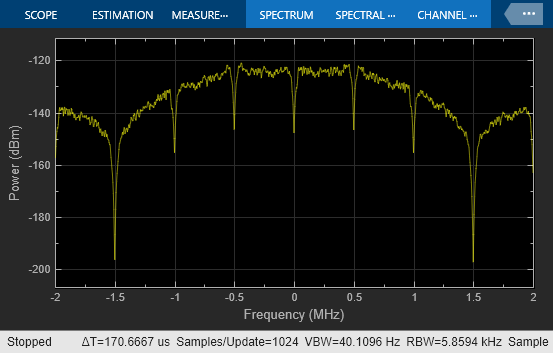Develop ZigBee-Like Baseband Transmitter and Receiver
This example shows how to develop a ZigBee-Like baseband transmitter and receiver. This example is a step one in designing a top-down RF receiver.
Develop ZigBee-Like Baseband Transmitter
To evaluate the performance of the RF receiver design, it is necessary and sufficient to use a signal spectrally representative of an 802.15.4 waveform.
The baseband transmitter model creates and illustrates a spectrally representative ZigBee waveform in the spectral and constellation domains. This model and all the subsequent models use callbacks to create MATLAB workspace variables that parameterize the systems.



Develop ZigBee-Like Baseband Receiver
To design the RF receiver, first determine the SNR needed to achieve the specified BER less than 1e-4, calculated in the simulation bandwidth of 4 MHz. Run the TopDownRFReceiverDesignLink.slx to simulate the receiver processing required to achieve the target BER.
In the link-level model, the top branch represents the baseband transmitter, the bottom branch the baseband receiver, and the AWGN block accounts for the overall RF receiver SNR budget.
Computing the BER accurately requires alignment of the transmit and receive signals. The simulation must compensate for a two-sample delay of the received signal compared to the transmitted signal. Also, to ensure correct chip-to-symbol-to-bit mapping, the simulation must align the chips to frame boundaries at the input to the Chips to Symbol block on a frame boundary. Accounting for the receive signal delay and the frame boundary alignment requires addition of a Delay block set to a 32-2=30 delay on the receiver branch before recovering the received symbols.


Determine SNR Specification
The simulation of the TopDownRFReceiverDesignLink.slx counting 100 errors or more, shows that a BER below 1e-4 is achieved with a signal-to-noise ratio equal to -2.7dB.